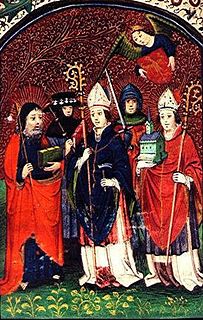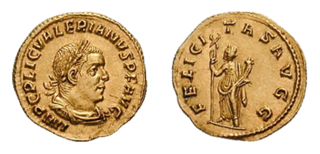
Pope Stephen I was the Bishop of Rome from 12 May 254 to his death in 257. Of Roman birth but of Greek ancestry, he became bishop after serving as archdeacon of Pope Lucius I, who appointed Stephen his successor.

Pope Cornelius was the Bishop of Rome from 6 or 13 March 251 to his martyrdom in 253. He was Pope during and following a period of persecution of the church and a schism occurred over how repentant church members who had practiced pagan sacrifices to protect themselves could be readmitted to the church. Cornelius agreed with Cyprian of Carthage that those who had lapsed could be restored to communion after varying forms of penance. That position was in contrast to the Novationists, who held that those who failed to maintain their confession of faith under persecution would not be received again into communion with the church. That resulted in a schism in the Church of Rome that spread as each side sought to gather support. Cornelius held a synod that confirmed his election and excommunicated Novatian, but the controversy regarding lapsed members continued for years.

Henry was a medieval English clergyman. He came to Sweden with Cardinal Nicholas Breakspeare in 1153 and was probably designated to be the new Archbishop of Uppsala, but the independent church province of Sweden could only be established in 1164 after the civil war, and Henry would have been sent to organize the Church in Finland, where Christians had already existed for two centuries.

Saint Erasmus of Formia, also known as Saint Elmo, was a Christian saint and martyr, who died c. 303. He is venerated as the patron saint of sailors and abdominal pain. St Erasmus or Elmo is also one of the Fourteen Holy Helpers, saintly figures of Christian tradition who were venerated especially as intercessors.

The Catholic Church in Portugal is part of the worldwide Catholic Church, under the spiritual leadership of the Pope in Rome. The Catholic Church is the world's largest Christian organisation. It is Portugal's largest religion and its former state religion, and has existed in the territory since the Iberian Peninsula was ruled by the Roman Empire.

Aug. 31 - Eastern Orthodox liturgical calendar - Sep. 2

February 10 - Eastern Orthodox liturgical calendar - February 12

Sep. 18 - Eastern Orthodox liturgical calendar - Sep. 20

Christianity has used symbolism from its very beginnings. Each saint has a story and a reason why they led an exemplary life. Symbols have been used to tell these stories throughout the history of the Church. A number of Christian saints are traditionally represented by a symbol or iconic motif associated with their life, termed an attribute or emblem, in order to identify them. The study of these forms part of iconography in art history. They were particularly used so that the illiterate could recognize a scene, and to give each of the Saints something of a personality in art. They are often carried in the hand by the Saint.
The Roman Catholic Archdiocese of Capua is an archdiocese of the Roman Catholic Church in Italy, but its archbishop no longer holds metropolitan rank and has no ecclesiastical province. Its see is in Capua, in Campania near Naples. Since 1979, it is a suffragan of the Archdiocese of Napoli in Naples, i.e. no longer has its own ecclesiastical province nor metropolitan status. In 2013 in the Archdiocese of Capua there was one priest for every 2,345 Catholics.

Saint Rumbold was an Irish or Scottish Christian missionary, although his true nationality is not known for certain. He was martyred near Mechelen by two men, whom he had denounced for their evil ways.

Saints Primus and Felician (Felicianus) were brothers who suffered martyrdom about the year 297 during the Diocletian persecution. The "Martyrologium Hieronymianum" gives under June 9 the names of Primus and Felician who were buried at the fourteenth milestone of the Via Nomentana.
Agapius of Spain was a Christian martyr and most likely a bishop who died under the persecutions of the emperor Valerian in AD 259. According to tradition he was a Spaniard, who along with some others was exiled by the Roman government to Africa. He was martyred along with several others at Cirta in 259.

Saint Eleutherius of Tournai is venerated as a saint and considered the first bishop of Tournai. The Catholic Encyclopedia writes that "historically there is very little known about St. Eleutherius, but he was without doubt the first Bishop of Tournai."
Saint Crispoldus is venerated as a 1st-century Christian martyr. He is the patron saint of Bettona, in Umbria, and said to have been the first bishop of that city, although the dioceses of Nocera and Foligno also include his name in episcopal lists.

Saint Dorothy is a 4th-century virgin martyr who was executed at Caesarea Mazaca. Evidence for her actual historical existence or acta is very sparse. She is called a martyr of the Diocletianic Persecution, although her death occurred after the resignation of Diocletian himself. She should not be confused with another 4th-century saint, Dorothea of Alexandria.

August 26 - Eastern Orthodox liturgical calendar - August 28

October 29 - Eastern Orthodox liturgical calendar - October 31












